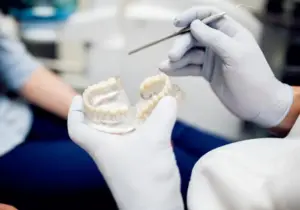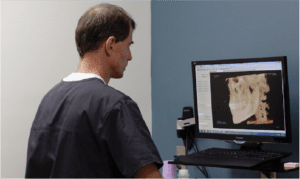We’ve all heard our dentist or oral surgeon sigh as they look at one of our dental x-rays and tell us it’s time to get our wisdom teeth removed. Well, most of us have, anyway. It was probably in high school or college, and once they spotted them on the x-ray, they likely told you to schedule a wisdom tooth removal with some sort of urgency. Why?
There’s the usual, blanket-statement reason: that if you leave them in there they can wreak all sorts of havoc. They can push other teeth around, misalign your bite, and even cause damage to your jawbone. But it’s not just the tooth “crown” floating around in there – the wisdom tooth roots are… the “root” of the problem, if you will. And these are the reason your oral surgeon shooed you back to the front desk to schedule a wisdom tooth extraction.
Why Does My Oral Surgeon Want to Remove My Wisdom Teeth?
It’s not the norm to have an oral surgery when there’s nothing that needs to be fixed. Except when it comes to wisdom teeth. The health of your mouth is largely maintained by preventative measures. Think about it – you don’t wait until you have cavities to start brushing your teeth; you brush your teeth so you don’t get cavities.
Wisdom tooth removal is the same idea. Leaving your wisdom teeth in might cause an issue; remove the teeth, remove the risks they pose. What possible complications come with leaving your wisdom teeth in? The main concern your dentist has with leaving that 3rd set of molars in is that, while they’re usually not the source of an ailment, they’re the cause of others. Wisdom teeth can:
- Cause other teeth to shift
- Increase risk of tooth decay
- Increase risk of gum infection
- Increase risk of cavity formation
- Cause abscess formation under the gums
- Increase risk of jaw infection
This is because most people in the US don’t have enough room for their wisdom teeth to fully erupt without disrupting the alignment of their bite. Basically, generations of soft foods have led to less-developed, smaller lower jaws. Smaller jaws mean less space for these gigantic back teeth.
Plus, because of said soft foods, we don’t really need them anymore – they’re for chewing hard-to-eat, fibrous plants and tough, cured meats. So, since we don’t need them, they might be trouble later, and removing them later in life is not fun, typical practice is to get them taken out in young adulthood soon after your body’s bones have finished growing.
Wisdom teeth as a whole can cause problems, but the roots are typically the culprit of more complicated issues brought on by failing to have them extracted preventatively.
Why Wisdom Tooth Roots Pose a Risk to Your Oral Health
What’s so special about your wisdom teeth’s roots? And why are they such a nuisance? A few reasons:
- Wisdom teeth roots are creepy. First, they have varying numbers of roots. As well, the roots are curved, or sometimes even sharply bent. Because your oral surgeon is not a psychic, they can’t predict how or how many roots will form on your wisdom teeth. It’s much easier to remove a wisdom tooth when the root isn’t fully grown or settled in the jaw.
- Wisdom tooth roots continue to grow over a long period of time, and as you age, the bone around them becomes denser, which is part of why getting your wisdom teeth removed later in life is more difficult with a longer recovery.
- The longer the roots of your wisdom teeth are allowed to grow, the closer they get to the sensory nerves, making extraction more difficult and recovery more uncomfortable. Occasionally, the doctor removing your wisdom teeth will only remove the crown, leaving the roots locked in the jaw. This is a way to minimize nerve damage and the invasiveness of the extraction process.
- Before your early 20’s, wisdom teeth roots are still lengthening, but not yet fully attached to the jaw. Once the jaw stops growing in your early to mid-20s, the roots will start to take hold. If you wait until your roots are fully… rooted, what would have been a simple wisdom tooth extraction may develop into an oral procedure that requires cutting into bone to get dense, tangled molar roots unstuck.
The Benefits of Having Your Wisdom Teeth Taken Out
There’s not exactly a consensus in the world of oral medicine when it comes to preventative wisdom tooth extractions. With close monitoring via dental x-rays and CT scans, one oral surgeon might decide there’s no need to take them out while another may decide it’s better to air on the side of caution.
Some people’s wisdom teeth come in just fine, their wisdom teeth’s roots don’t get wayward and gnarly, and they never pose a risk to their oral health. Even luckier people don’t have wisdom teeth at all. And the very least lucky of us have double sets of wisdom teeth. So that’s a bummer.
The other thing that makes getting your wisdom teeth out early a good idea is the cost perspective. Preventative extractions are usually straightforward; dental insurance covers them because of that risk-benefit ratio. If they pay for you to get your wisdom teeth taken out now, they eliminate the risk of having to dole out money for surgeries needed because of wisdom tooth complications later. As a result, getting wisdom teeth extracted is pretty cheap.
So, the urgency of a wisdom tooth extraction isn’t actually urgent – wisdom teeth roots are slow moving, much like tree roots. But also much like tree roots, when they do become rooted, they’re not easy to disrupt. Extracting the wisdom teeth before that stage of growth means a simple, quick removal process that isn’t invasive, often doesn’t require bone grafting, and results in an easy recovery process.









